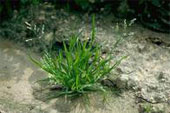Question and Answer – April 2009
We’ve had a ton of questions this month, but very few with photos. We’ve also been overrun with weed control questions.

Question: How can I eliminate this weed? It spreads quickly. Is this a weed that is controlled with 2,4-D? Is there anything I should do this fall to prevent it next time? J.M., Lewisville.
Answer: You’re correct – this is a broadleafed weed, therefore any of the 2,4-D mixes would control it. Do not mow for several days before or after you treat, and give the herbicide 10-15 days to do its job. You could apply Gallery granules in very early September to stop additional sprouting of next year’s crop.

Question: I’ve become very frustrated by this little weed. Regular herbicides don’t seem to phase it. I did research online this past week, and I think it’s annual bluegrass. How can I get rid of it? J.B., Trophy Club.
Answer: You only get one chance per year to stop annual bluegrass (Poa annua), and that comes with a pre-emergent weedkiller treatment the first week of September. If you wait until later, you’ll miss it. Once it germinates, you just have to wait it out. It dies away by mid-April, but it has sown thousands of seeds by that time. You can eliminate it in driveways and open spaces with one of the glyphosate sprays such as Round Up, but those should not be used within turf.

Question: Our mesquite tree is being overrun with mistletoe. We have read that it helps to cut it out. Should we do that? It’s common in our area. M. and H.D., Lewisville.
Answer: Pruning is your only option. Mistletoe is a parasitic plant. That means that it’s actually rooted into the wood of the tree, so any treatment you might apply to the mistletoe will probably damage the tree. Remove new clumps as soon as you see them each year. Prune them off, twig and all. However, once they’re established and their branches have grown larger, all you can do is to keep them nipped back.

Question: We are building our first pool, and our back yard is a blank canvas. The east side of the pool has a 30-degree slope, and there are about 5 feet to the fence. What will hold the soil? We also need privacy quickly. We’d like a tropical look. J.W., DFW area.
Answer: Your best plant for privacy in a narrow area would be Little Gem southern magnolia. They are egg-shaped (fat end at the bottom), and they grow to 20 or 25 feet tall and 18 to 20 feet wide. You’d want to space them 16 to 18 feet apart. Large specimens are easy to find in the nursery trade. Another option would be a smaller magnolia with even larger leaves, one called Teddy Bear. I haven’t seen mature plants of this one yet, but we’re told it stays shorter than Little Gem. Each of these trees is evergreen and reasonably litter-free. They do, of course, have the normal magnolia leaf drop in late spring, but the leaves are large and easily skimmed from the pool. They can be trimmed up so that their lower branches will clear the fence.
As for holding the soil, I normally recommend purple wintercreeper euonymus in sunny areas and mondograss where there is little or no sunlight. Both have comparatively fine textures, which will give a nice contrast with the trees.
As for creating the tropical look, that’s a very common request, and I always warn people that Hawaii never freezes (other than the mountain tops). It does freeze where you are, so most tropical plants will have to be used during the warm months alone. However, if you concentrate on a nice mix of unusual textures and bright colors, you can come very close with a lot less effort. Mary Nell hollies (sun or shade), for example, have large leaves, as does aspidistra (full shade only). Junipers (sun only), nandinas (sun or part sun), liriope (shade or morning sun), mondograss (shade or morning sun) and ferns (shade only) all have fine textures. Use crotons as annuals, also mandevilla vines and tropical hibiscus. Cannas, pentas, moss rose, purslane and trailing lantanas are commonly seen in tropical gardens. Keep the lantanas away from water’s edge, as they shed flowers. Let a nurseryman or landscape contractor work with you on a planting plan. The pool will be lovely. A real pro who can see it on-site will have really great suggestions. The plants I’ve listed are only starters.

Question: I have tried Round Up to kill this weed, also trumpetvine, all to no avail. What can I do? This weed is growing into my azaleas, elephant ears and just about everywhere. The trumpetvine just keeps sending up sprouts. D.M., Southlake.
Answer: Round Up is a grass killer, and neither this weed nor trumpetvine is a grassy weed. You need the broadleafed weedkiller I mentioned earlier (containing 2,4-D). You’ll have to use a foam rubber paintbrush to apply it beneath your azaleas and elephant ears, since it can also kill them. As for the trumpetvine, drill into the stump of the original plant to make a finger-sized reservoir, then pour the full-strength broadleafed weedkiller into the hole. It will soak into the wood and kill the plant. You may have to repeat it a time or two, and you’ll probably need to spray the sprouts that are coming up individually with the same broadleafed herbicide, but at the rates recommended for spraying on the label.

